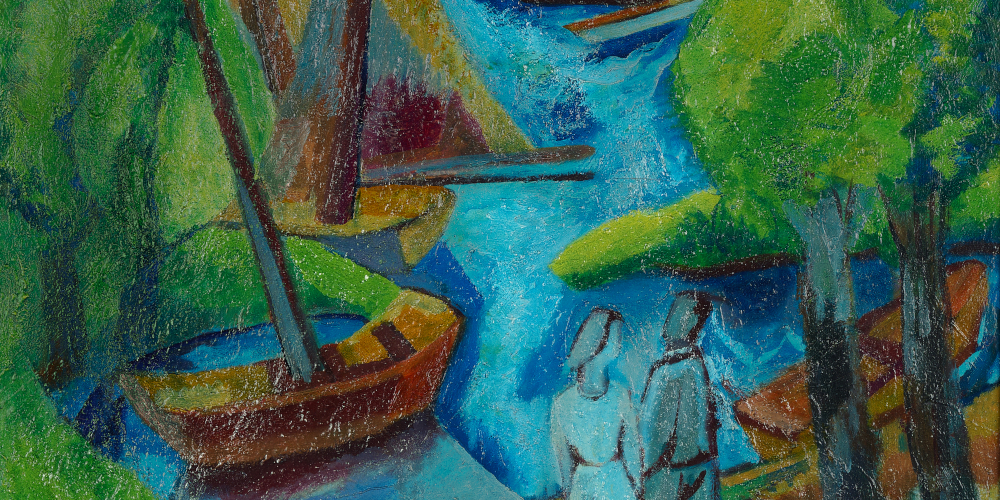

With the acquisition of two estates relating to the artist Fritz Schaefler - the extensive Schaefler family estate in Cologne and the estate of the Heymann family of collectors in London and Berlin, formerly Cologne - VAN HAM Art Estate proves its commitment to the art-historical maintenance of classical modernism in two respects: it includes an important painter of a somewhat younger Expressionist generation to its portfolio and at the same time provides a further basis for research into Rhenish art of the interwar period.
Born on 31 December 1888 in Eschau, Bavaria, Fritz Schaefler studied architecture at the Technical University of Munich in 1905, attended the School of Arts and Crafts there from 1906 and the Royal Academy of Fine Arts from 1908 (under Angelo Jank, among others). In his Schwabing studio and at Lake Simssee, Schaefler then created numerous paintings in a late impressionist-naturalistic style, which were still being shown at the Secessions in Berlin and Munich in 1915/16. After military service and being wounded in the First World War, he settled back in Munich in 1917 and the following year married Vera Linzen (1895-1938), the daughter of the writer Clara Ratzka (1871-1928), with whom he had a son Hannsotto (1918-1983).
In the wake of the war, a new phase of his work emerged with dramatic expressionist prints including apocalyptic and religious motifs, which were exhibited at the Goltz Gallery in 1918. Schaefler subsequently took part in the Munich Revolution, was a member and secretary of the "Action Committee of Revolutionary Artists" and produced woodcuts for the revolutionary magazines "Der Weg" and "Süddeutsche Freiheit". He also produced numerous graphic portraits of the most important personalities of the Soviet Republic. Many artist friendships date from this period, such as with Georg Schrimpf, Paul Klee, Erich Heckel and Heinrich Maria Davringhausen.
After 1919, Schaefler also had to flee Munich. He first went to Austria to Alfred Kubin and settled with his family in Prien am Chiemsee in 1920. This relocation launched a new work phase with expressionist landscape and figure paintings in a strongly animated and colourful style. His friendship with Kurt Gerstenberg was significant. They travelled to Italy in 1923 and Gerstenberg was often able to place works by Schaefler with collectors.
These contacts also included the Cologne textile manufacturer Joseph Heymann (1887-1954), who gradually became Schaefler's main collector and probably also influenced his move to Cologne in 1927.
In addition to an improved commission situation, the lively Cologne art scene favoured his work as well. New friendships developed with the "Cologne Progressives" around Heinrich Hoerle and Franz Wilhelm Seiwert, Anton Räderscheidt and the architects Wilhelm Riphahn and Hans Hansen. He took over Davringhausen's flat and studio in Cologne-Bickendorf, the new Riphahn housing estate, for which he also worked as a colour designer. Many public commissions continued to follow - colour concepts for new housing estates, hospitals or for the German Hygiene Exhibition in Dresden in 1930, as well as a large number of stained glass windows and murals (including St. Nikolaus Bensberg and Wipperfürth Town Hall). Schaefler also became known as a passionate organiser of artists' festivals at the Cologne Carnival. The themes of his works, which have now taken on firmer contours, have expanded to include pictures of city views and of urban life itself.
Schaefler's artistic career suffered severe setbacks during the National Socialist era. The Jewish Heymann family emigrated to England with their art collection in 1937, and Schaefler's works were confiscated from museums and shown in the "Degenerate Art" exhibition. He himself married a second time after the tragic suicide of his wife Vera. With Elisabeth Höffken, he fled from Cologne to the Bergisches Land region to escape the bombs of the war. After the end of the war, he lived secluded in Cologne, where he died on 24 April 1954 and was finally buried in Bensberg. His memory was preserved by his grandson Christoph Schaefler (1951-2017). Fritz Schaefler's written documents will be preserved in the Rheinisches Archiv für Künstlernachlässe (RAK) Bonn.
Text: Adam C. Oellers

VAN HAM, Köln, 20.03. – 14.04.2025